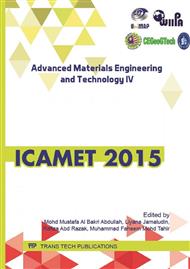p.503
p.509
p.514
p.519
p.524
p.530
p.535
p.540
p.547
Hot Solvent Extraction Method for Recycle Epoxy Resin in Waste Printed Circuit Board with Polyethylene Glycol
Abstract:
Waste printed circuit board (WPCB) from waste electrical and electronic equipment (e-waste) can be recycled a precious metal part while a non-metal part was burned or landfilled, which normally generated toxic substance of organic component to environment. The research work aimed to recycle epoxy resin by hot solvent chemical extraction. Polyethylene glycol 400 (PEG400) and ethylene glycol (EG), at 180°C, were mainly using as solvent and sodium hydroxide (NaOH) as a catalyst. Extraction method was reflux technique. The thermogravimetric analysis (TGA), Specific viscosity, and Fourier transform infrared spectroscopy (FT-IR) methods were investigated and discussed. The TGA result showed that the organic composition was 40.73%wt. The maximum of percent yield was 97.89% at non-metal WPCB/PEG, equal to 0.05 g/ml. Moreover, the extracted product presented a functional group close to virgin epoxy resin according to the peak of FT-IR data. The recycled epoxy resin could be formed well on specimen by virgin epoxy resin and hardener filled with 50% recycled extraction product.
Info:
Periodical:
Pages:
524-529
Citation:
Online since:
May 2016
Keywords:
Price:
Сopyright:
© 2016 Trans Tech Publications Ltd. All Rights Reserved
Share:
Citation:


